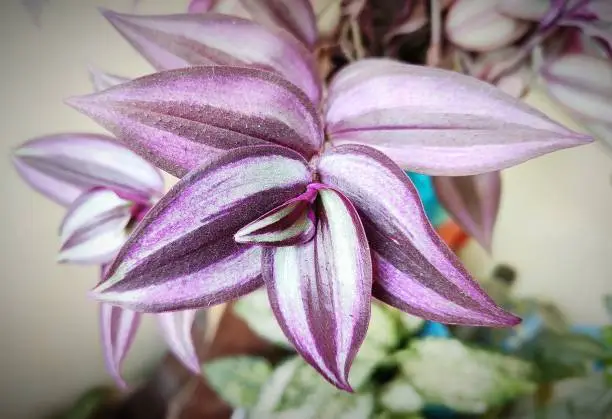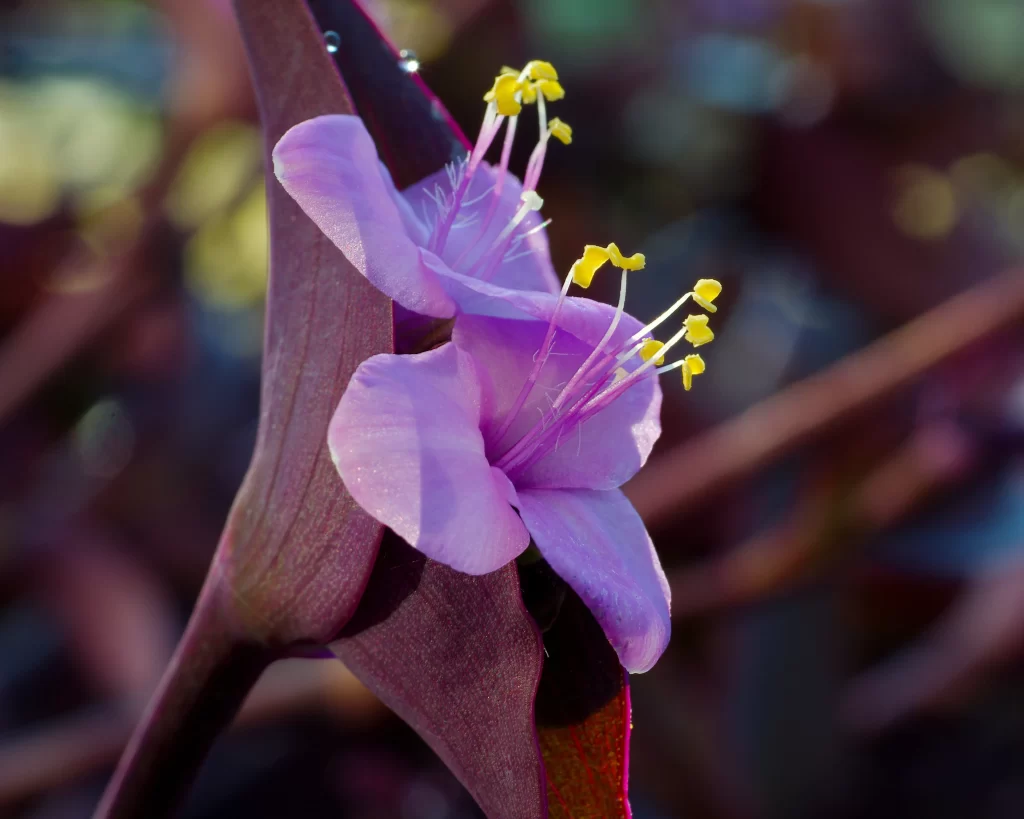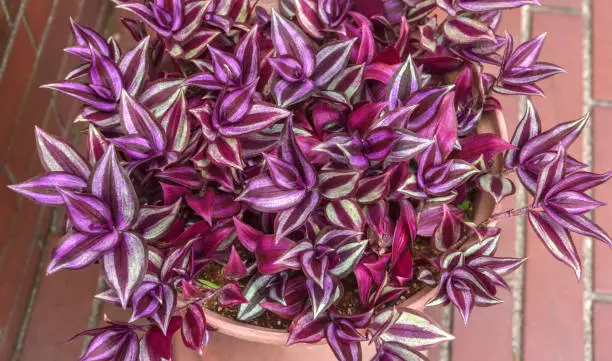Spiderwort (Tradescantia), a member of the Commelinaceae family, goes by various common names such as inch plant, striped wandering Jew, and wandering Jew[1]Wandering Jew Plant Varieties. Read. This succulent evergreen herbaceous plant boasts spreading stems that are hairless and purple-red, producing roots at the joints. The leaves exhibit green, silver, and purple longitudinal stripes on the upper surface, with purple undersides ranging from egg-shaped to broadly sword-shaped.
Read: Dragon Fruit Plant: Varieties, Propagation, and Care
However, Flowers bloom in bright pink or purple clusters at the stem tips, followed by small capsules containing brown seeds. Spiderwort has spread throughout roadside vegetation, forests, and coastal scrublands. as an ornamental plant introduced initially in Mexico.

Spiderwort or Tradescantia
Spiderwort, or Tradescantia, is a beautiful flowering plant from Central America, the Caribbean, and North America. Its arching stems and captivating flowers make it a showstopper in any garden. The flowers open in the morning and close by midday, creating a dynamic display. Spiderwort is easy to care for and thrives in a variety of conditions. It is a charming addition to gardens, bringing elegance and natural beauty to your outdoor space.
Commelina benghalensis
This plant, known as wandering Jew[2]Read More About Commelina benghalensis. Read, Bengal dayflower, and tropical spiderwort, is a creeping herb with oval dark green leaves with pointed tips, featuring reddish hairs on the leaf sheath and delicate lilac-blue flowers. It is originally from tropical and subtropical African, Asian, and Pacific regions and can be found in various habitats. Thriving in moist conditions, it exhibits high drought tolerance once established. The highly adaptable plant can spread through seeds, runners, and stem fragments.
Tradescantia Blossfeldiana
The Tradescantia Blossfeldiana, also known as Tradescantia Cerinthoides, is a rare and captivating flowering plant with flaunting short stems and glossy, fleshy, lance-shaped purple hue leaves. These perennials bloom from March to July, showcasing clusters of three triangular petals in shades of purple, blue, white, or rose pink. They make great air purifiers and thrive indoors and outdoors with indirect sun and regular watering. Perfect for ground covers or hanging baskets.
Ohio Spiderwort
The Ohio Spiderwort, also known as Bluejacket, is a unique member of the wandering Jew family, with arching leaves forming up to eight nodes. It has clusters of vibrant purple-blue flowers and can reach heights of 2-3 feet. This resilient perennial is drought-tolerant but prefers moist, well-draining soil and thrives best in full sun with a touch of shade or filtered light. Native to Missouri and the heart of North America, it’s a charming addition to your garden, bringing a touch of unique elegance and resilience to your green space.
Tradescantia zebrina or Zebrina pendula
The Wandering Jew[3]Explore More About Zebrina pendula. Read is a tropical plant that can be used as a groundcover or hanging plant. It can grow up to 2 feet tall and thrives in semi-shaded areas, especially coastal ones. It has uniquely patterned leaves and petite pink blooms. It’s easy to nurture and can grow in USDA Zones 9-11. It needs lightly damp soil and a bit of fertilizer during the growing season. It’s also a resilient and visually stunning addition to your warm-weather garden. The T. zebrina features boat-shaped flowers in white, lavender, or purple with three petals and prominent yellow anthers. It’s fast-growing, easily propagated from cuttings, and can fill spaces around tall tropicals.
Tradescantia zanonia or Commelina zanonia
The Mexican Flag is a captivating tropical plant. It has ornamental foliage resembling ginger and is related to the Rheo family. The broad, wide leaves have bold white variegation and thrive in semi-shades with regular watering and a 2 to 5 feet height. The Mexican Flag has delicate white or off-white flowers, adding to its scenic presence. If you want to add a unique charm to your garden, the Mexican Flag is a perfect choice.
Tradescantia virginiana, Tradescantia x andersoniana
The Virginia Spiderwort, or Lady’s Tears, is a low-maintenance ground-hugging plant that grows up to 2 feet tall. It features lush green lance-shaped leaves and spectacular flowers in various pink, white, blue, lavender, and purple hues, blooming in late spring or early summer. This plant is easy to care for and adapts to various soil types and climates, thriving in full sun or semi-shade. It is cold-hardy in USDA zones 4-9, making it a perfect choice for landscape use.
Rheo or Oyster Plant
The Boat Lily, also known as Rheo or Oyster Plant, is a fascinating herb originating from the West Indies and Mexico. Its succulent stems and unique leaves, dark green on top, and a captivating purple or green below, create an ornamental spectacle with 2 feet in height. It’s a resilient choice for seaside gardens, showcasing salt tolerance.
Tradescantia sillamontana
Tradescantia sillamontana, aka White Velvet or Cobweb Spiderwort, is a low-growing wonder that adds whimsy to your garden with fuzzy silver-green leaves and magenta flowers. It’s easy to care for and grows to only 2 feet tall and 10-12 inches wide, thriving in semi-shaded areas with minimal water and well-drained soils. Resilient in zone 7B, it’s perfect for containers, rock gardens, and walls. Add a touch of magic to your garden with White Velvet Spiderwort.
Purple Heart
Originating from the sunny landscapes of Louisiana, Florida, and Eastern Mexico, the Purple Heart is a low-growing wonder that forms a lush ground cover with semi-evergreen foliage. It showcases a deep purple hue in full sun and a rich dark green in semi-shade at 2 feet. This easygoing perennial is a breeze to care for, thriving in zones 9 to 11 with regular water and a taste for full sun. This plant flourishes in colder months.

Tradescantia navicularis
The Chain Plant, or Tradescantia navicularis, is a charming succulent native to Peru. This low-growing plant can reach up to two feet in height, making it an excellent groundcover that’s easy to spread and transplant. Its boat-shaped, grey-green leaves have fine hairs, offering a unique texture to any garden. It prefers semi-shade and humidity but is resilient enough to thrive in various conditions. It shows off its beauty in summer and autumn with charming pink flowers. It’s drought-tolerant, requires moderate water, and is perfect for USDA Zones 9-11.
Inch Plant
The Inch Plant, also called the White-Flowered Wandering Jew, is a versatile vine that can add elegance to your garden. It has lush foliage, tiny succulent oval leaves with green or purple hues, and small white flowers. It needs regular watering and tolerates moderate water delays. Best suited for USDA Zones 9-11, it’s a salt-tolerant beauty that can add texture and dimension to your outdoor haven. However, be careful when handling it to avoid skin irritation.
Read: How to Propagate Wandering Jew Plant

Tradescantia fluminenis
The Wandering Jew[4]Explore More About Tradescantia fluminenis. Read is an aggressive ground cover from South America that has become a regional pest in Auckland, New Zealand. It can smother native plants and cause allergic dermatitis. The plant spreads rapidly through stem fragments. Its sale, propagation, and display are restricted in the Auckland region due to its detrimental impact on the ecosystem.
Furry Kittens
Furry Kittens is a charming evergreen plant from Eastern Africa, Rwanda, and Somalia. Resilient and low-maintenance, it blooms bright blue or lavender-purple flowers and has lance-shaped leaves hidden beneath a furry trail of stems. Suited for USDA Zones 10-11, it forms a low-growing ground cover of 2 feet or a small shrub reaching 2-5 feet in colder climates. You can enjoy its whimsical charm with compost, considerable moisture, and strategic watering.
Read: 35 Most Popular Snake Plant Varieties
Additional Information: Periwinkle
Periwinkle (Vinca major) is a plant that can hinder the growth of native plants by forming dense ground covers. It has oval, glossy green leaves and mauvish-blue flowers that emerge from the leaf axils. Originally from the Mediterranean, Periwinkle has become naturalized in New Zealand. It often spreads through dumped garden waste, and manual removal is a recommended control method.
Read: Goldfish Plant – Care, Propagation, and Varieties
Conclusion
It is also known as an inch plant or spiderwort and is botanically famous as Tradescantia zebrina. However, the wandering jew plant has occupied many names due to its diversity in region, shape, size, flowering, and other annual and perennial characteristics. This article has demonstrated the names used for wandering jew plants worldwide.



